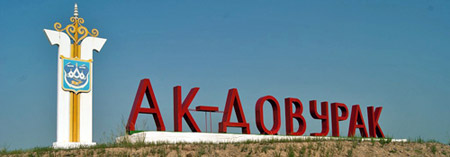

Ak-Dovurak is a city in the Republic of Tyva of the Russian Federation. It forms the urban district, the city of Ak-Dovurak, as the only settlement in its composition.
The population is 13769 people (January 1, 2021), has remained at a stable level over the past decade (13468 in 2010; 12965 in 2002; 15191 in 1989; 13216 in 1979; 9613 in 1970). According to the All-Russian Population Census of 2010, 94.3% of the population are Tuvans. The villages of Kyzyl-Mazhalyk, Aksy-Barlyk, Bizhiktig-Khaya, Barlyk, Shekpeer and Don-Terezin surrounding the city have close economic and social ties with it, together with them the population of Ak-Dovurak is 23392 people (2018). Buddhists predominate among believers.
It arose in 1959 as a settlement of builders of the Tuvaasbest plant in the Barun-Khemchik district of the Tuva Autonomous Region. Since 1964 - the city. In 1964–1994 was part of the Barun-Khemchik region of the Tuva ASSR (1964–1991), the Tuva SSR (1991), the Republic of Tuva (1991–1993), the Republic of Tyva (1993–1994). Since 1994 - a city of republican subordination (values) of the Republic of Tuva. Since 2004, it has been forming the Ak-Dovurak urban district.
In the 1960s the first multi-apartment four- and five-story residential buildings were built in the village of Constant, secondary school No. 1 (1965), the building of the city vocational school No. 41 (1966; now - Ak-Dovurak Mining College), a hospital campus (1967). In 1965–1976 the main building of the 2nd stage of the Tuvaasbest plant was built. Among the buildings of the 1970s - 1980s: the Palace of Culture named after Kadr-ool Sagdy (opened in 1972), a sports complex (opened in 1982).
The Ak-Dovurak Mining Technical School (founded in 1966 as city vocational school No. 41, after repeated changes since 2012 - the current status and name), 4 general education schools, 7 preschool institutions, 4 organizations of additional education: an education center, a house of children's creativity, center for the development of creativity of children and youth, sports school.
The name of the city is translated from Tuvan as “white land”. It is associated with an asbestos deposit, which is described in a Tuvan legend: “In time immemorial, kind and courageous people lived here, they raised and grazed cattle. But one day they were attacked by fierce warriors. For three days and three nights, brave people fought with the enemy until the last warrior fell. The cruel khan ordered to burn the surviving old people, widows and children on a high mountain peak. The earth turned black from grief, and the heart of a good people turned into an eternal stone - asbestos. "
Geographical position
It is located in the west of the Tuva
basin, on the left bank of the Khemchik River (left tributary of the
Yenisei), in the center of the Khemchik valley, 309 km west of
Kyzyl, 428 km from the Abakan railway station. The city is the
western economic center of Tuva and is located at the intersection
of the end of the Abakan-Ak-Dovurak highway and the Kyzyl-Teeli
highway (former A162).
The city of Ak-Dovurak is located in the time zone MSK + 4. The time offset from UTC is +7: 00.
The climate is moderately cold with a lot of
precipitation. The average annual temperature is −0.7 ° C. About 279
mm of precipitation falls annually.
The least amount of
precipitation falls in February. Most of the precipitation falls in
July, about 58 mm.
The highest temperature in July is 18.9 °
C, the lowest in January is on average -24.0 ° C.
The total number of able-bodied population is 7388 people (54.2% of
city residents, 2018); the city's economy employs 2,621 people (2018).
The level of officially registered unemployment is 3.57%, according to
the methodology of the International Labor Organization - 20% (2018).
About 70% of the working population (2019) is employed in the public
sector: in public administration, education and healthcare. The volume
of shipped products of the city's enterprises is 108.1 million rubles.
(2019).
The city-forming enterprise - Mining and Processing Plant
(GOK) "Tuvaasbest" (in 1976–2014 - named after V.I. Lenin) was launched
in 1964, simultaneously with the assignment of Ak-Dovurak city status,
for the extraction and enrichment of chrysotile-asbestos ores
Aktovraksky deposit and production of long-fiber asbestos, slate and
other materials (as part of the GOK - mines, processing plant). After
1991, it experienced stagnation, after privatization and transfer to
private ownership, the work of the plant was practically stopped,
attempts were made to restore production with the help of federal and
private investments, and in 2021, part of the production facilities was
dismantled.
In Ak-Dovurak there are food industry enterprises
(bread and bakery products) and building materials industry.
The
service sector is represented by a hotel with 56 beds (2019) and small
trade enterprises.
Agricultural production in Ak-Dovurak is
concentrated in personal subsidiary plots of the population. Ak-Dovurak
has 636 personal subsidiary farms with 2,794 head of cattle (2019).
Farms of all categories harvested 122.4 tons of potatoes and 37.8 tons
of vegetables, produced 41 tons of livestock and poultry meat, 273 tons
of milk and 27 thousand eggs (2020).
In Ak-Dovurak, as well as in Kyzyl, there are four mobile operators - Beeline, MTS, MegaFon and ETK.
Near Ak-Dovurak there are burial mounds and groups (Ak-Dovurak 1–4, in the tracts of Edegey, Kozheelig-Khovu, etc.) of the 1st millennium BC - 1st millennium AD. (Uyuk culture, Turks), there are also memorial monuments in the form of fences and balbals. The locations of petroglyphs from the Bronze Age to the Middle Ages are also known (Sary-Dash, Katyn-Shat 2, etc.) 6.5 km north-west of the city, on the banks of the Edegeychik River, there is the site of Malgash-Bazhin, an Uighur fortification of the 8th–9th centuries .